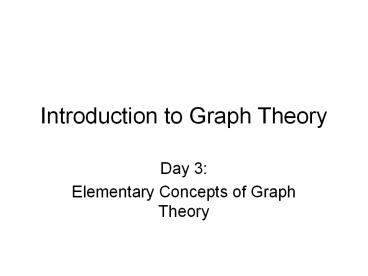Introduction to Graph Theory - PowerPoint PPT Presentation
Title:
Introduction to Graph Theory
Description:
Introduction to Graph Theory Day 3: Elementary Concepts of Graph Theory – PowerPoint PPT presentation
Number of Views:235
Avg rating:3.0/5.0
Title: Introduction to Graph Theory
1
Introduction to Graph Theory
- Day 3
- Elementary Concepts of Graph Theory
2
Subgraphs
- Let G be a graph. A graph H is a subgraph of G if
- and
If a graph F is isomorphic to a subgraph of
H of G, then F is also called a subgraph of G. - Find all subgraphs of K4, up to isomorphism.
3
u-v walk
- Let u and v be vertices in a graph G. A u-v walk
in G is a sequence of adjacent vertices in G
starting with u and ending with v. - Give two different u-v walks for the graph below.
4
u-v trail/path
- A u-v trail in a graph G is a u-v walk which does
not repeat any edge. - Are the u-v walks given on the previous slide u-v
trails? - A u-v path is a u-v walk which does not repeat
any vertex. - Is a u-v path necessarily a u-v trail?
5
Connected
- Two vertices u and v in G are connected if uv or
there is a u-v path. - A graph G is connected if every pair of vertices
in G are connected. Otherwise, G is disconnected. - The maximal connected subgraphs of G are called
the components of G. Notice that a connected
graph has only one component. - Give an example of a disconnected graph with
three components.
6
Circuits and Cycles
- A u-v trail in which uv and which contains at
least one other vertex is called a circuit. - A circuit which does not repeat any vertices
(except for the first and last) is called a
cycle. - Give an example of a graph for which every
circuit is a cycle.
7
Exercises
- Let G be a graph of order 13 with three
components. Explain why one of the components
must have 5 vertices. - Let G be a graph of order p where p is even such
that G has two complete components. Prove that
the minimum size possible for G is q(p2-2p)/4.
If G has this size, what does G look like?
8
Exercises
- Let G be a graph, and let R denote the relation
is connected to on the set V(G). Show that R is
an equivalence relation. Determine the
equivalence classes. - HW page 43, 27, 28, 39, 40
9
Subtraction
- If e is an edge of the graph G, then G-e is the
subgraph of G with all the same vertices as G and
all the edges except for e. - If v is a vertex of G, then G-v is the subgraph
of G with all the vertices of G except for v and
all the edges of G except for the edges which are
incident to v.
10
Cut-vertex
- A vertex v in a connected graph G is a cut-vertex
if G-v is disconnected. - Draw a graph with no cut-vertices.
- Draw a graph with two cut-vertices.
11
Bridge
- An edge e in a connected graph G is a bridge if
G-e is disconnected. - Draw an example of a graph G with a bridge.
- If e is a bridge in a graph G, how many
components does G-e have?
12
Bridges
- Theorem 2.5 Let G be a connected graph. An edge
e of G is a bridge if and only if e does not lie
on any cycle of G.
13
Exercises
- Let G be a connected graph containing only even
vertices. Prove that G cannot contain a bridge. - Let G be a connected graph, and let u, v, and w
be three vertices of G. Suppose that every u-w
path contains v. What property does v have? Why?
14
Exercises
- Prove or give counterexample If G is a connected
graph with a cut-vertex, then G has a bridge. - HW pages 47-48, 45, 46, 50, 54, 55

